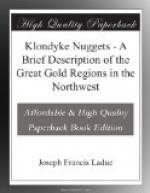“Mr. Campbell dropped down the river, and met some of the local Indians who returned with him, but the robbers had made their escape. I have heard that the local Indians wished to pursue and overtake them, but to this Mr. Campbell would not consent. Had they done so it is probable not many of the raiders would have escaped, as the superior local knowledge of the natives would have given them an advantage difficult to estimate, and the confidence and spirit derived from the aid and presence of a white man or two would be worth much in such a conflict.
“Mr. Campbell went on down the river until he met the outfit for his post on its way up from Fort Yukon, which he turned back. He then ascended the Pelly, crossed to the Liard, and reached Fort Simpson, on the Mackenzie, late in October.
“Mr. Campbell’s first visit to the site of Fort Selkirk was made in 1840, under instructions from Sir George Simpson, then Governor of the Hudson’s Bay Company. He crossed from the head waters of the Liard to the waters of the Pelly. It appears the Pelly, where he struck it, was a stream of considerable size, for he speaks of its appearance when he first saw it from ‘Pelly Banks,’ the name given the bank from which he first beheld it, as a ‘splendid river in the distance.’ In June, 1843, he descended the Pelly to its confluence with the larger stream, which he named the ‘Lewes.’ Here he found many families of the native Indians—’Wood Indians,’ he called them. These people conveyed to him, as best they could by word and sign, the dangers that would attend a further descent of the river, representing that the country below theirs was inhabited by a tribe of fierce cannibals, who would assuredly kill and eat them. This so terrified his men that he had to return by the way he came, pursued, as he afterwards learned, by the Indians, who would have murdered himself and party had they got a favorable opportunity. Thus it was not until 1850 that he could establish, what he says he all along believed, ‘that the Pelly and Yukon were identical.’ This he did by descending the river to where the Porcupine joins it, and where in 1847 Fort Yukon was established by Mr. A.H. Murray for the Hudson’s Bay Company.
“With reference to the tales told him by the Indians of bad people outside of their country, I may say that Mackenzie tells pretty much the same story of the Indians on the Mackenzie when he discovered and explored that river in 1789. He had the advantage of having Indians along with him whose language was radically the same as that of the people he was coming among, and his statements are more explicit and detailed. Everywhere he came in contact with them they manifested, first, dread of himself and party, and when friendship and confidence were established they nearly always tried to detain him by representing the people in the direction he was going as unnaturally bloodthirsty and cruel, sometimes asserting the existence of monsters with supernatural powers, as at Manitou Island, a few miles below the present Fort Good Hope, and the people on a very large river far to the west of the Mackenzie, probably the Yukon, they described to him as monsters in size, power and cruelty.




